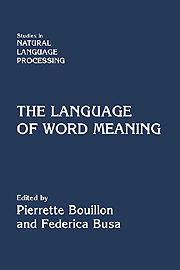Book contents
- Frontmatter
- Contents
- List of Contributors
- Preface
- Introduction: Word Meaning and Creativity
- Part I Linguistic Creativity and the Lexicon
- 1 Introduction
- 2 Chomsky on the Creative Aspect of Language Use and Its Implications for Lexical Semantic Studies
- 3 The Emptiness of the Lexicon: Critical Reflections on J. Pustejovsky's “The Generative Lexicon”
- 4 Generativity and Explanation in Semantics: A Reply to Fodor and Lepore
- 5 The “Fodor”-FODOR Fallacy Bites Back
- Part II The Syntax of Word Meaning
- Part III Interfacing the Lexicon
- Part IV Building Resources
- Index
5 - The “Fodor”-FODOR Fallacy Bites Back
Published online by Cambridge University Press: 07 October 2011
- Frontmatter
- Contents
- List of Contributors
- Preface
- Introduction: Word Meaning and Creativity
- Part I Linguistic Creativity and the Lexicon
- 1 Introduction
- 2 Chomsky on the Creative Aspect of Language Use and Its Implications for Lexical Semantic Studies
- 3 The Emptiness of the Lexicon: Critical Reflections on J. Pustejovsky's “The Generative Lexicon”
- 4 Generativity and Explanation in Semantics: A Reply to Fodor and Lepore
- 5 The “Fodor”-FODOR Fallacy Bites Back
- Part II The Syntax of Word Meaning
- Part III Interfacing the Lexicon
- Part IV Building Resources
- Index
Summary
Abstract
The paper argues that Fodor and Lepore (1998) are misguided in their attack on Pustejovsky's Generative Lexicon, largely because their argument rests on a traditional, but implausible and discredited, view of the lexicon on which it is effectively empty of content, a view that stands in the long line of explaining word meaning (a) by ostension and then (b) explaining it by means of a vacuous symbol in a lexicon, often the word itself after typographic transmogrification. Both (a) and (b) share the wrong belief that to a word must correspond a simple entity that is its meaning. I then turn to the semantic rules that Pustejovsky uses and argue first that, although they have novel features, they are in a well-established Artificial Intelligence tradition of explaining meaning by reference to structures that mention other structures assigned to words that may occur in close proximity to the first. It is argued in Fodor and Lepore's view that there cannot be such rules is without foundation, and indeed systems using such rules have proved their practical worth in computational systems. Their justification descends from line of argument, whose high points were probably Wittgenstein and Quine that meaning is not to be understood by simple links to the world, ostensive or otherwise, but by the relationship of whole cultural representational structures to each other and to the world as a whole.
- Type
- Chapter
- Information
- The Language of Word Meaning , pp. 75 - 86Publisher: Cambridge University PressPrint publication year: 2001
- 1
- Cited by



